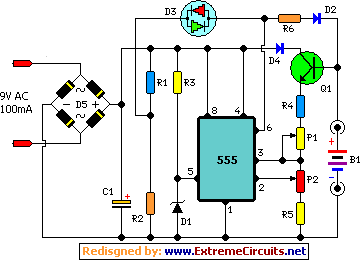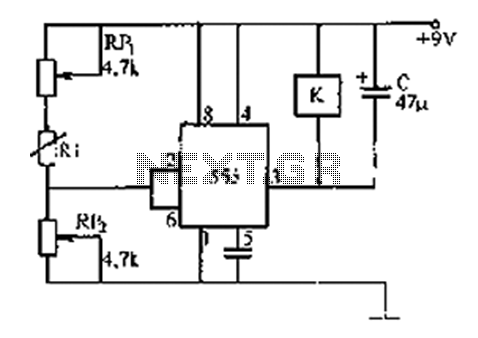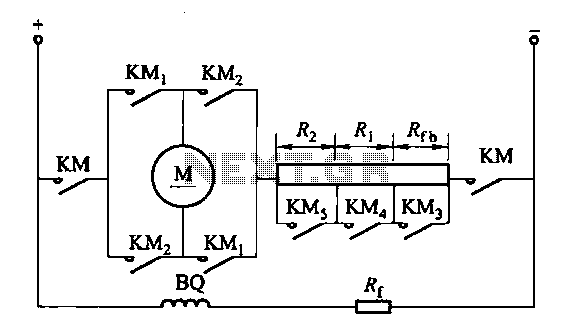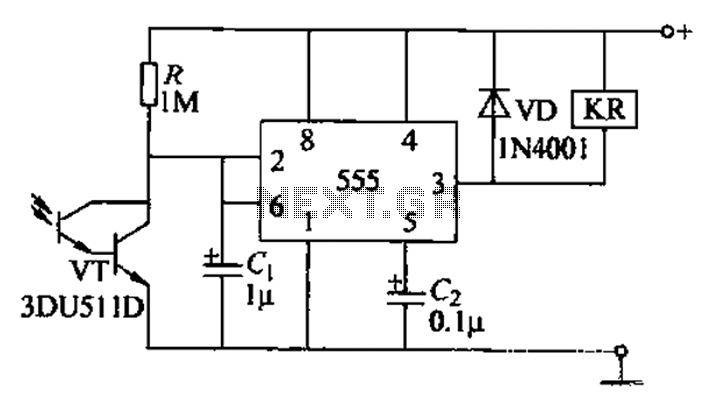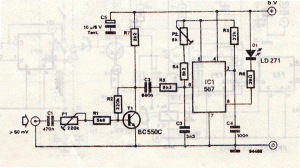
Dc/Dc Converter Circuit

This low-power converter supplies approximately 100 mW of DC power to a load and is useful for isolating or deriving DC voltages. It operates at a frequency of around 200 kHz. The inductor is wound on a 22-mm diameter, 13-mm high pot core using #32 magnet wire. The primary winding consists of 80 turns, and the secondary winding also has 80 turns, designed for a nominal output of 12 V. The two windings must be insulated to withstand the expected voltage difference between the input and output in insulation applications.
This low-power DC-DC converter is designed to efficiently deliver power while providing electrical isolation between its input and output. The converter's operating frequency of approximately 200 kHz allows for compact transformer design, which is beneficial for applications where space is limited. The choice of a pot core with a diameter of 22 mm and a height of 13 mm enables effective magnetic coupling between the primary and secondary windings, optimizing the energy transfer.
The use of #32 magnet wire for the windings ensures that the wire can handle the required current levels while minimizing losses due to resistance. With both the primary and secondary windings consisting of 80 turns, the transformer is configured for a 1:1 turns ratio, facilitating a nominal output of 12 V from the secondary winding when the input voltage is appropriately selected.
In applications where insulation is critical, the windings must be adequately insulated to prevent breakdown or arcing due to the voltage difference between the input and output. This insulation must be rated for the maximum expected voltage and should comply with relevant safety standards to ensure reliable operation.
Overall, this converter is suitable for various low-power applications where isolation and voltage derivation are necessary, including sensor power supplies, portable devices, and other electronic systems requiring a stable DC voltage source. Proper attention to winding insulation and component selection will enhance the reliability and performance of the converter in its intended use. This low-power converter will supply about 100 mW of dc to a load and it is useful to isolate or derive dc voltages. It operates at around 200 kHz. LI is wound on a 22-mm diameter 13-mm high pot core with #32 magnet wire. The primary is 80 turns and the secondary is 80 turns (for 12- V nominal output). The two windings should be insulated for the expected voltage difference between input and output in insulation applications.
This low-power DC-DC converter is designed to efficiently deliver power while providing electrical isolation between its input and output. The converter's operating frequency of approximately 200 kHz allows for compact transformer design, which is beneficial for applications where space is limited. The choice of a pot core with a diameter of 22 mm and a height of 13 mm enables effective magnetic coupling between the primary and secondary windings, optimizing the energy transfer.
The use of #32 magnet wire for the windings ensures that the wire can handle the required current levels while minimizing losses due to resistance. With both the primary and secondary windings consisting of 80 turns, the transformer is configured for a 1:1 turns ratio, facilitating a nominal output of 12 V from the secondary winding when the input voltage is appropriately selected.
In applications where insulation is critical, the windings must be adequately insulated to prevent breakdown or arcing due to the voltage difference between the input and output. This insulation must be rated for the maximum expected voltage and should comply with relevant safety standards to ensure reliable operation.
Overall, this converter is suitable for various low-power applications where isolation and voltage derivation are necessary, including sensor power supplies, portable devices, and other electronic systems requiring a stable DC voltage source. Proper attention to winding insulation and component selection will enhance the reliability and performance of the converter in its intended use. This low-power converter will supply about 100 mW of dc to a load and it is useful to isolate or derive dc voltages. It operates at around 200 kHz. LI is wound on a 22-mm diameter 13-mm high pot core with #32 magnet wire. The primary is 80 turns and the secondary is 80 turns (for 12- V nominal output). The two windings should be insulated for the expected voltage difference between input and output in insulation applications.
